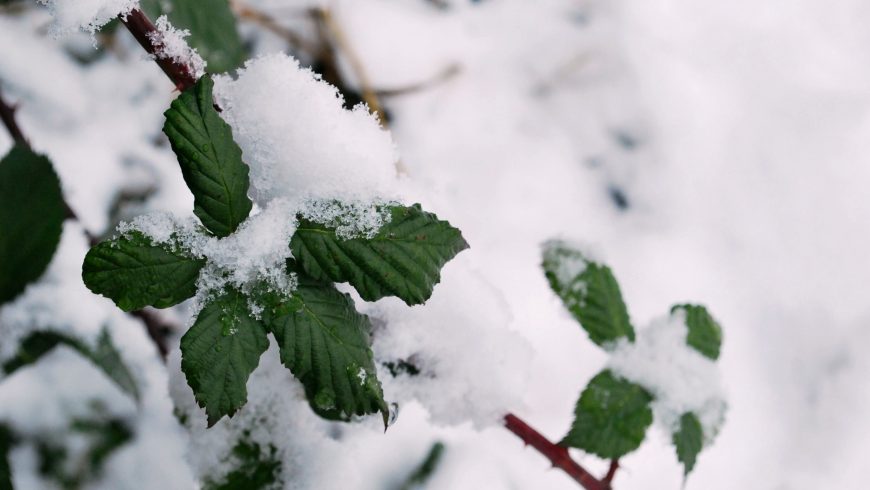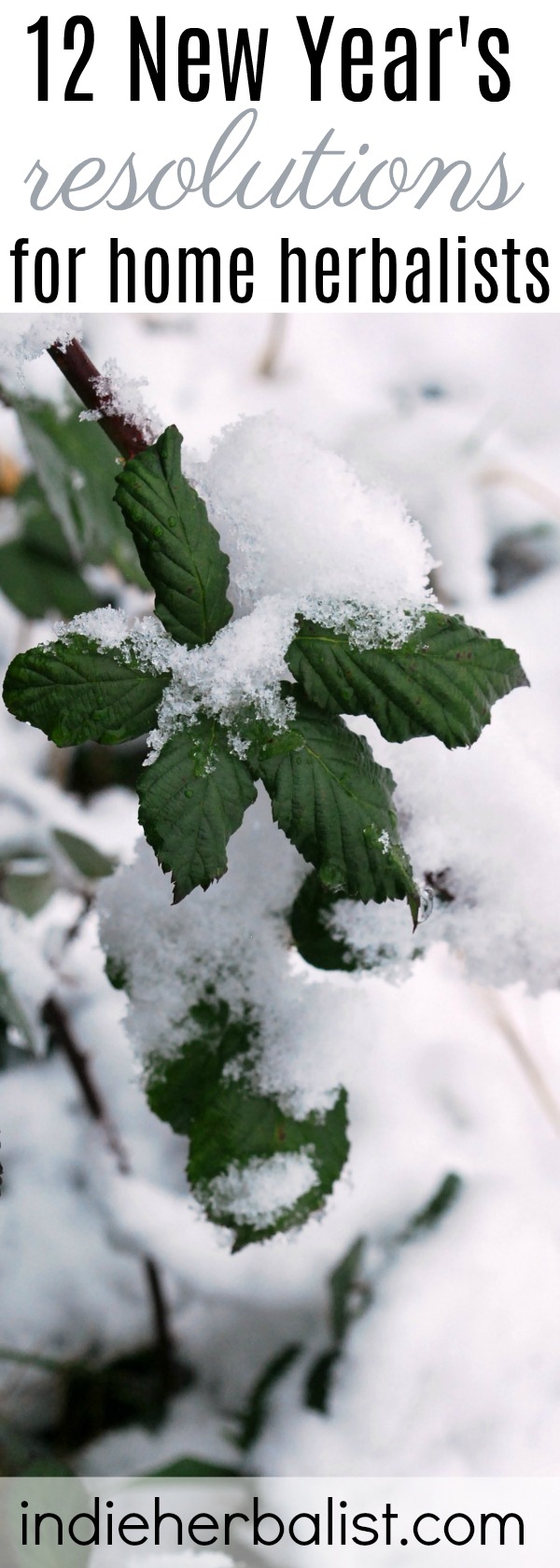Links contained in this post and elsewhere on my website may include affiliate links. When you make a purchase through these links, I earn a commission at no additional cost to you. I only link to products and services that I love - and that I think you will love, too!
One of my favorite traditions for New Year’s is making a list of herbalist New Year’s resolutions. My resolution list includes projects or activities I want to try in the coming months that will help me grow as an herbalist. Over the years, my list has included
- recipes I wanted to try
- herbal books to read
- new plants to add to the garden
- and new topics of interest
Creating an herbal lifestyle that is gorgeous, delicious, and amazing at every turn should be at the top of the list for every home herbalist going into the new year. This tradition is the perfect way to set your intentions for a very herbal year to come. Here are some fun ideas to help you brainstorm things to include.
Take more plant walks
Plants are at the heart of what we do. Every herbalist benefits from feeling connected to their local ecosystem! Find a hiking trail, neighborhood walking route, or local park and observe the plants growing there.
It’s best to do this on a regular schedule. For example, explore the same location once a month for a whole year. This helps you experience the seasonal cycles of plants. Remember to take a field guide and learn to identify the plants you see.
Start a materia medica
A personal herb journal, or materia medica, is one of the best herbal learning tools! A materia medica is a type of plant journal and encyclopedia used to record information about individual herbs.
It can take many different forms – some herbalists prefer a computer file, others might keep a beautiful sketchbook with handwritten notes. If you are interested in starting your own materia medica, I highly recommend the Herbal Materia Medica Course by Herbal Academy. I worked on the writing team for this course and love how it turned out. Each lesson guides you through the process of creating a materia medica entry.
Make herb and flower jelly
Mint, rose, lavender, dandelion- if you can make a tea with it, you can turn it into a jelly! These unusual herbal delicacies are fantastic on home-baked goodies or even in meat and vegetable dishes. You can also stir them into yogurt or oatmeal for a breakfast upgrade.
Dandelion jelly is one of my favorites, and I have directions for making your own in my article Celebrate Spring with Homemade Dandelion Jelly.
Take time for tea parties
Herbal teas are good for you and come in an astounding array of flavors and varieties. I like to take a thermos of herbal tea along on spontaneous picnics for outdoor tea parties.
I’ve also been known to bake cookies and share with friends for full moon tea parties. Whether you enjoy with friends or by yourself is up to you. But adding herbal tea parties to your routine is definitely fun!
Grow a new herb
An herbalist New Year’s resolution to work on your green thumb is always a good thing. Every herbalist should try growing a plant at least once, right? Be careful, though, you might get hooked- tending plants can be addictive.
Buying a plant is a good investment for first-time gardeners. Herb seeds can be a tad finicky. . . .ok, actually, they can be a pain in the backside! Some of them take a whole year of twiddling their thumbs underground before they sprout.
Tulsi (Ocimum africanum or O. tenuiflorum) is a good choice to grow from seed. It’s an adaptogen that doubles as a houseplant with a sunny spot indoors. Jiaogulan (Gynostemma pentaphyllum) is another adaptogen that makes an exceptional little houseplant.
Make an herbarium
Looking for a crafty herbalist New Year’s resolution? Try making an herbarium! An herbarium is a collection of dried, pressed leaves or flowers. It can be a lovely way to catalog what you have been growing in your garden, make some lovely framed artwork for your living space, or be used as a learning tool as you identify new plants.
Trees are often overlooked by the beginning herbalist, but creating an herbarium is a great project if you are interested in studying trees with herbal uses. You can include bark rubbings and drawings or photos of the twigs, leaves, and buds to create your own field guide.
So many trees have provided medicinal barks, leaves, and flowers throughout history, not to mention fruit, nuts, dyes, basketry and furniture-making materials. So why not spend a little time getting to know them?
Choose an herbal ally for the year
Having an herbal ally, a plant that resonates with your specific health needs or your intentions for the year, can be a beautiful way to celebrate and develop your connection to herbs. Depending on which herb you chose, you may be able to incorporate your ally into your life as a flower essence, a tea you can enjoy regularly, or even a potted plant on your windowsill.
Allies often become a connection we can return to again and again for self-care and to reaffirm our relationship with herbalism. Alexis at Worts and Cunning has an incredible resource for getting to know your herbal ally better: the Plant Ally Project Thirty Day Challenge is the perfect way to start the year with your new ally.
Learn the art of herbal self care
Who agrees, 2020 was beyond extra? Here’s hoping that 2021 will be calmer, but if it’s not – well, it’s the perfect time to learn about using herbs for self-care. As usual, the Herbal Academy has the perfect short course for the occasion.
Herbal Self Care for Stress Management guides you through herbs, lifestyle, and diet to navigate whatever 2021 has in store with grace and poise.
Consider adding an adaptogen
Adaptogens are probably one of the best things you can do for your health, herbally speaking. These herbs are traditionally revered as tonics that support wellness and longevity. Modern research continues exploring the ways they can help support our energy levels, response to stress, and immunity.
An adaptogen extract is part of my morning routine, and then I also enjoy using adaptogens creatively in recipes throughout the day. My book, The Complete Guide to Adaptogens, has many of my favorite recipes in it!
(It’s also available in Spanish and German, if you’d prefer).
Experiment with herbal fermentation
Herbs can add an intriguing dimension to your home brewing escapades. Did you know that you can make vanilla meadowsweet mead or nettle beer? What about herbal kombucha?
You could also experiment with herbal infused wines. Herbal infused wines, which start with either a homemade or store-bought fruit wine, can be incorporated into menu plans, enjoyed on special occasions, or help set that perfect seasonal mood. In addition to being used in more traditional ways, of course.
The Herbal Academy has an incredible course devoted to the craft of herbal fermentation. Herbal beer, wine, mead, and kombucha are all covered in the course, and there’s even a unit that covers herbs and Lacto-fermented foods.
Get creative in the kitchen
Sure, everyone’s familiar with a sprinkling of so-called culinary herbs in recipes to add flavor and spice to cooking. But did you know that you can use herbs to infuse oils, butter, salt, and vinegar for even more incredible variety? If you haven’t ever experimented with these wonderful recipes, you definitely should. A great example is my recipe for Chive Butter Blossoms. Floral herbs are definitely wonderful for getting creative in the kitchen with herbs – dandelions, violets, and roses lend themselves to many interesting recipes.
Learn to love bitters
Bitter flavored herbs were once an important aspect of the herbal recipe compendium; more and more people are once again becoming familiar with the ways bitters can benefit digestion and wellness! Whether you try an herbal coffee substitute, add dandelion greens to your dinner plate, make a simple single herb extract with angelica or dandelion root, or try one of the excellent herbal bitters blends already available from companies like Urban Moonshine, there are plenty of ways to experience herbal bitters.
Herbalist New Year’s resolution: take a new course
I try to take at least one short online class every year. I enjoy studying with the Herbal Academy and with herbalist Matthew Wood and have taken several of their courses. In 2020, I took the Austere Acute Care course with herbalist Sam Coffman.
You can also try one of my affordable short courses at Teacup Alchemy. These are new for 2021 and I’m so excited to offer affordable courses on unique herbal topics.
Try out an Herbarium subscription
If you’d like an herbal membership option that includes articles, intensives, and an herbal profile database, the Herbal Academy’s Herbarium is perfect!
The Herbarium online learning resource by the Academy is one of my fav recommendations for indie herbalists looking for an affordable way to access a wealth of quality information about herbs.
It’s a great place to start when researching new additions to your materia medica. Every month, they add new articles and herbal profiles to the searchable database. It’s literally everything you could want in an herbal study resource.
Enjoying the journey with herbalist New Year’s resolutions
I hope that this year is brighter and more peaceful for everyone than last year. At the very least, may everyone enjoy connecting with the beauty and joy that can be found in the herbal world.

